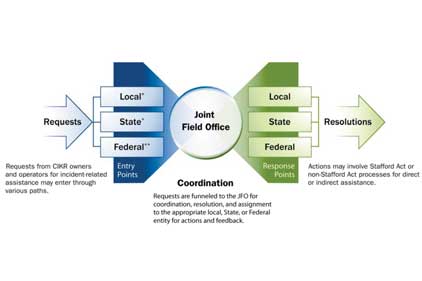Since 9/11, the Department of Homeland Security has identified 18 Critical Infrastructure and Key Resource Sectors (CIKR).
Be informed, equipped and prepared
The 18 CIKR are: Chemical Sector; Commercial Facilities; Communications; Critical Manufacturing; Dams, which include levees, navigation locks and other similar water retention facilities; Defense Industry; Emergency Services; Energy; Financial; Food and Agriculture; Government Facilities; Healthcare and Public Health; Information Technology; Nuclear, both reactors, materials and waste material; Transportation; Postal & Shipping; National Monuments and Icons; and Water and Wastewater.
The following is an attempt to give you a taste of the networking, information sharing, threat analysis and warnings, and general information on security, preparedness and sustainability available for your organization’s protection if you are part of a CIKR.
How to gather intelligence
- Homeland Security Information Network – (HSIN) is a DHS newsletter devoted to sharing pertinent security information on a national level. HSIN also produces The HSIN Advocate, a homeland security electronic newsletter available at: http://content.govdelivery.com/accounts/USDHSIN/bulletins/7d10c4.
- DHS – Critical Infrastructure Open Source Highlights CIKRISE.dhs@public.govdelivery.com. DHS offers a multitude of informative sources depending on what industry and aspect you are interested in. Another example is produced by the Office of Emergency Communications official eNewsletter available at OEC@dhs.gov. Examples of DHS products available to your organization include: Incident Reports, Spot Reports, Threat Warnings, Terrorist Target Selection Matrix, Attack-Specific Threat Scenarios and Sector-Specific Threat Assessments.
- Inside Homeland Security – a quarterly publication produced by the American Board for Certification in Homeland Security, http://www.abchs.com/ihs/index.php.
- The Federal Bureau of Investigation has multiple networking opportunities as well as information-sharing products. One initiative is the Federal Bureau of Investigation local chapters of InfraGARD.® Application available at: https://www.infragard.org/.
- The National Cyber Awareness System (NCAS) produces Weekly Analytic Synopsis Product (WASP) reports available at: http://www.us-cert.gov/ccubedvp/getting-started-sltt.
- FEMA Disaster Declaration Update is a good source to gather information on new or ongoing disaster events, whether man-made or natural. Retrieve at: http://www.fema.gov/disaster/4185.
- The Early Bird Brief from Defense News offers a source for current events affecting national and local defense and security issues. Retrieve at: http://www.defensenews.com/article/20131101/DEFREG02/311010013/The-New-Early-Bird-Brief-Now-Available
- 4 The Global Security Newswire is another excellent source of a broad spectrum of national and international information. Registration at: http://www.nti.org.
Plug into your organization’s available sources of information, intelligence and networking. Weave Homeland Security into your fabric of operation to stay abreast of your industry’s hot topics. Be proactive to combat detrimental consequences, and increase your emergency preparedness and business continuity.



